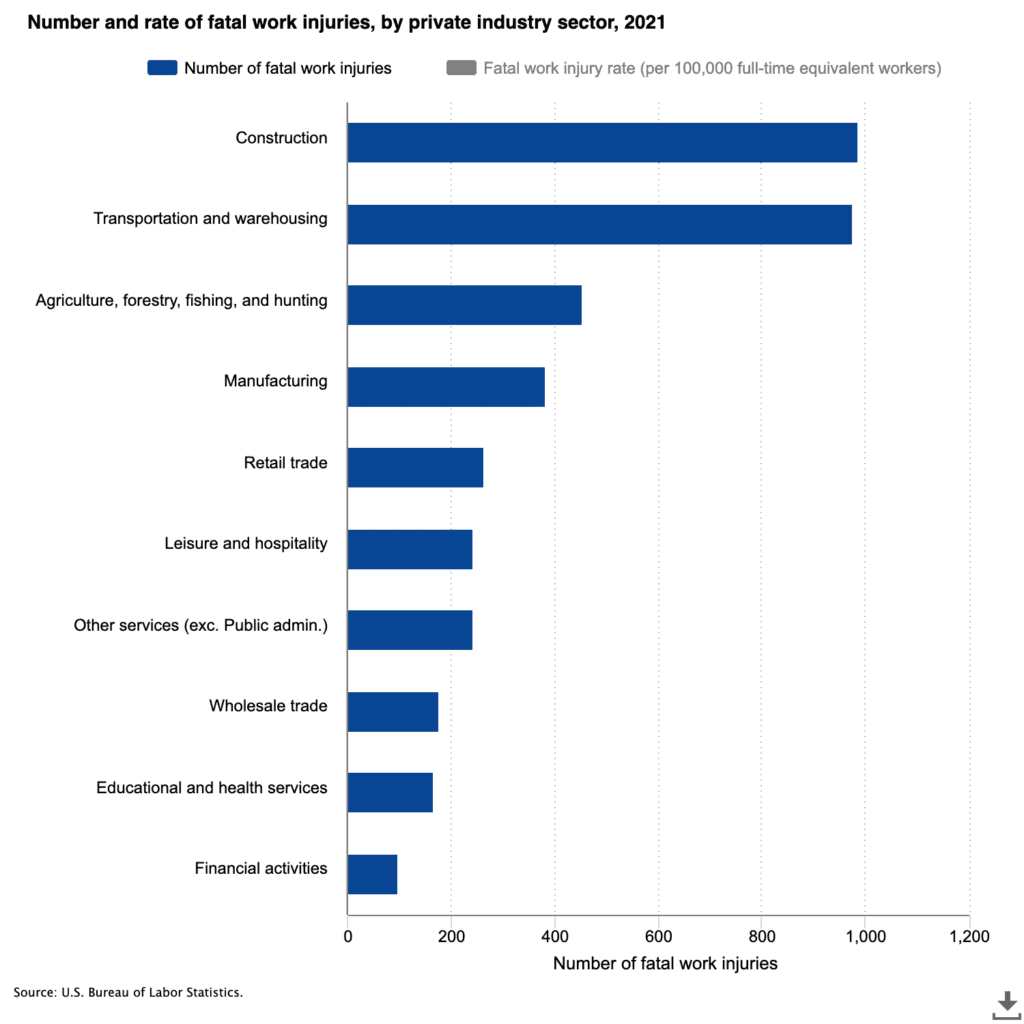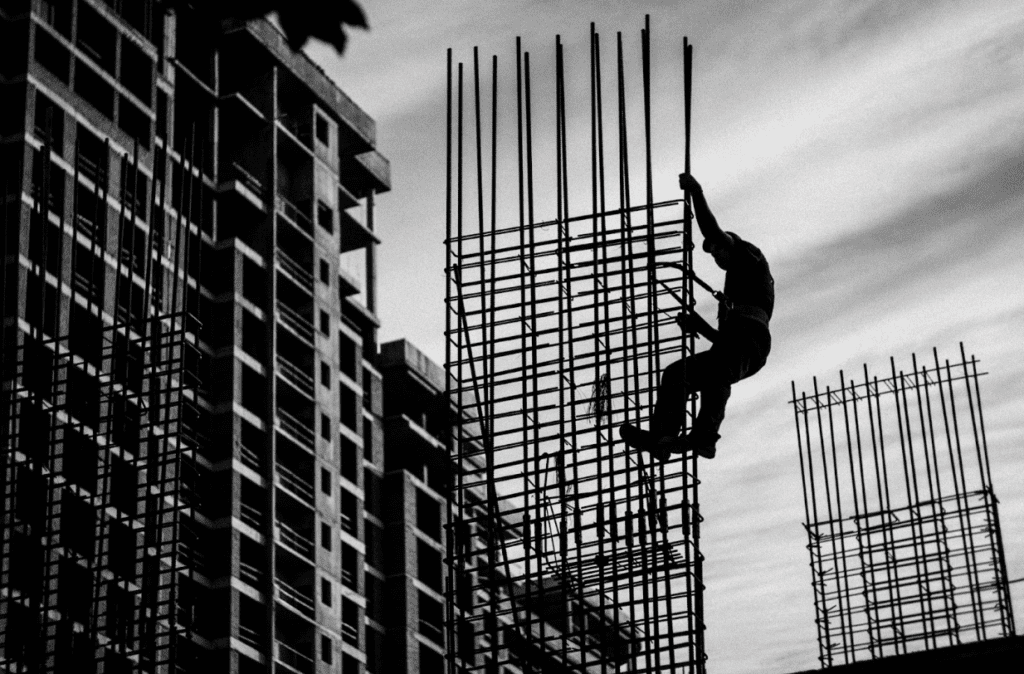
New York City is known for its massive construction projects, whether they be to house the millions of people that call New York City home, provide office and retail spaces for businesses, or facilitate needed gathering places. Nearly 200,000 New York City residents work in construction and risk their lives to make our city a wonderful place to live and work.
Construction is certainly a dangerous line of work. In fact, when compared with other industries, construction consistently ranks the highest in terms of workplace injury.

A 2021 report by the Bureau of Labor Statistics (BLS) listed construction as the industry sector with the highest rate of fatal work injury. This has consistently been the case for decades. According to NYC.gov, in 2022, 11 construction workers lost their lives while working on construction projects in NYC (1).
The National Institute for Occupational Safety and Health (NIOSH) reported that “Falls remain the leading cause of work-related deaths in construction, accounting for more than one in three (36.4%) of the total number of fatalities in this industry” (2).
While these statistics can be disheartening, New York’s construction workers have greater protection to sue for injuries sustained on the job than their counterparts do in many other states.
As accident attorneys specializing in New York’s labor laws, we point to New York Labor Law Section 240 (the Scaffold law), 241(6) (Industrial Code Violations), and some others as key pieces of legislature protecting New York’s Construction workers. We encourage construction workers and their families to become familiar with these laws.

New York Labor Laws – An Overview
New York has a long history of enacting laws that exist to protect construction workers injured while working. Namely, state law sections 200, 240, or 241 describe several types of workplace injury and the causes of each. If a worker were to sustain an injury on a construction site, consulting an attorney experienced with New York’s labor laws is an important first step.
New York Labor Law 200
Known as Common Law Negligence, NY Labor Law 200 mandates that construction company owners, contractors, and other parties exercise precautions to provide a safe working environment for construction workers. More specifically, this law requires that reasonable protection is applied for construction workers who operate equipment, devices and machinery, as well as things like adequate lighting and safety guardrails to prevent falls. This law also covers visitors to construction and job sites.
New York Labor Law 240
Known commonly as “The Scaffold Law,” Labor Law 240 provides additional protection for construction workers who risk injury from a fall or due to a falling object striking them. If a worker sustains injury described under the Scaffold Law, that worker can recover against a third-party on or affiliated with the job site.
It is important to note that NY Labor Law 240 provides recovery for injured workers beyond what would normally be obtained through workers’ compensation.
The construction company is responsible for providing protective equipment and enforcing the use of such equipment for everyone on the construction site.
Eligibility Requirements for Injuries Covered by the Scaffold Law:
Unlike Labor Laws 200 and 241, Labor Law 240 is quite specific in its rules and their application to the injuries sustained. While it imposes strict liability against the property owner, many courts use an extremely strict interpretation of the law.
For example, one and two-family homeowners are not held to the same standard of absolute liability as would a larger-scale construction project. That is, unless the homeowner assumes the role of a project director or supervisor.
This law certainly applies to owners of apartment buildings, three or more family homes, and any commercial building.
The following are examples of types of construction work that are covered under Labor Law 240:
- Alterations
- Cleaning
- Demolition
- Erection of building materials
- New building construction
- Painting
- Pointing a building
- Repairing
Further, it is important to distinguish the difference between actual construction and any type of maintenance or decorative work. Under the Scaffold Law, the claimant must be engaged in actual construction.
It is important to remember that the mere fact of elevation does not qualify injured workers to recover under the Scaffold Law if the same type of injury could have occurred while the construction worker was on the ground.
To qualify, he or she must have fallen from an elevated surface or have been injured due to a falling item.
Leav & Steinberg Fights to Recover for Client Injured Under the Scaffold Law:
In October 2021, a client of Leav & Steinberg suffered an accident while working on a job site in Manhattan. While working, a 24-foot, 1000-pound steel pipe which was being lifted with a hitch spun off a hillside out of control, striking our client in his torso. The incident involved adjacent pipes as well, as construction material landed on top of our client, causing him to black out and suffer memory loss.
As a result of this incident, our client suffered very significant injuries, including multiple broken ribs, a severe brain bleed resulting in a traumatic brain injury, as well as a knee injury requiring surgery, and neck and back injuries. Without question, he has and will be unable to perform work as normal for the foreseeable future.
Several of the aforementioned rules make this case applicable to recover under New York’s Scaffold Law. Our team of attorneys is fighting to ensure that our client receives full compensation for his injuries and is using Labor Law 240 to do so.
New York Labor Law 241
New York Labor Law 241 refers to equipment — specifically demolition, excavation, and safety equipment. Similar to previous sections, Section 241 requires employers and contractors to provide reasonable and adequate safety precautions — and enforce adherence to such precautions.
The difference here is that Section 241 extends beyond those construction workers at risk of “gravity-related” injuries to include other types of activities like demolition and excavation.
Our Team of Attorneys Can Help
Injured workers often are hesitant to pursue a personal injury claim under New York’s labor laws because they fear that they would become ineligible to receive worker’s compensation. However, these types of financial compensation for injury have no impact on the other.
Construction workers who suffered injury due to the negligence of their employer or property owner have the right to pursue legal action under these three sections of NY state labor law.
If you or a loved one has been injured while working on a construction site, you’re well advised to consult a lawyer that will fight aggressively to recover under the laws available to protect you.
Our team of attorneys at Leav & Steinberg are well-versed in labor law and can help you navigate the many complexities and rules typical of these personal injury cases. We offer a free-consultation should you wish to evaluate your rights to recover as a result of workplace injury.
Resources:








